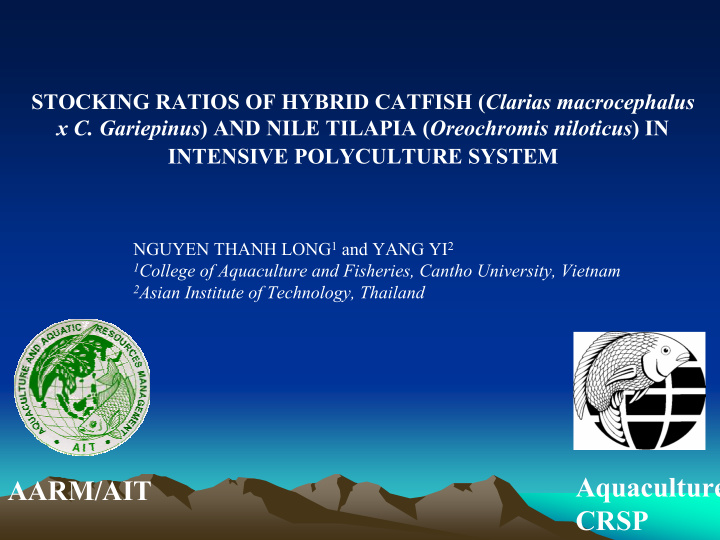



STOCKING RATIOS OF HYBRID CATFISH ( Clarias macrocephalus x C. Gariepinus ) AND NILE TILAPIA ( Oreochromis niloticus ) IN INTENSIVE POLYCULTURE SYSTEM NGUYEN THANH LONG 1 and YANG YI 2 1 College of Aquaculture and Fisheries, Cantho University, Vietnam 2 Asian Institute of Technology, Thailand Aquaculture AARM/AIT CRSP
INTRODUCTION � Hybrid catfish has become one of the most popularly cultured freshwater fish in Southeast Asia. � Main problem of intensive hybrid catfish culture is environmental pollution. About 78.8% of N and 85.5% of P from feed input are released into the surrounding water lost from catfish cage culture. � Many previous studies have proven that Tilapia can utilize nutrition of waste for their growth in integrated systems successfully by reusing nutrition from the waste in culturing systems. So, it is very important to study the stocking ratio of Nile tilapia to hybrid catfish in intensive polyculture.
Objectives � To compare the growth performance of hybrid catfish and Nile tilapia in polyculture at different stocking ratio � To compare water quality in polyculture at different stocking ratio � To determine the nutrient utilization efficiency and nutrient budget in polyculture at different stocking ratios � To compare the economic returns in polycultrure at different stocking ratios � To determine and recommend the appropriate stocking ratio of Nile tilapia to hybrid catfish in intensive polyculture systems
Methodology Experimental tank systems Experimental period: 3/3/2003 to 2/6/2003 Experimental site: 15 outdoor concrete tanks at AIT hatchery Tank area: 5- m 2 ; Water level: 0.9m; Covered by net; Aeration system.
Experiment Design Treatments T1 T2 T3 T4 T5 T6 T7 Stocking ratios 0:100 5:100 10:100 15:100 20:100 25:100 30:100 (Tilapia:H. catfish) Replications 3 2 2 2 2 2 2 Size of fingerlings: Hybrid catfish: 25.4 g Nile tilapia: 20.4 g � Kind of feed: CP feed (crude protein 30%) � Feeding: 2 times at 0830h and 1530h and 6 days per week � Feeding rate: 5% of BWD (<100 g), and 3% BWD (>100g). � Feeding rates was based only catfish biomass estimated by biweekly fish sampling
RESULTS AND DISCUSSION Growth performance of hybrid catfish cultured in the monoculture and polyculture system for 91 days
Growth performance of Nile tilapia cultured in the polyculture system for 91 days
Relationship between mean weights of Nile tilapia and stocking ratios
Relationship between net yields of Nile tilapia and stocking ratios
Relationship between gross yields of Nile tilapia and stocking ratios
Relationship between combined gross yields and stocking ratios
Distribution (%) of TN and TP in the polyculture system of hybrid catfish and Nile tilapia
Values of water quality parameters measured at the end of the monoculture and polyculture systems of hybrid catfish and Nile tilapia
Partial budget analysis (Baht) for hybrid catfish and Nile tilapia polyculture in the 91-day experiment (based on 5-m 2 cement tanks)
CONCLUSIONS � Growth of Nile tilapia decreased linearly with increased stocking ratios of Nile tilapia to hybrid catfish; however, growth of hybrid catfish was not significantly different among all stocking ratios � With increasing stocking ratios of Nile tilapia to hybrid catfish from 0:100 to 30:100, net and gross yields of Nile tilapia and Nile tilapia plus hybrid catfish increased linearly, while net and gross yield of hybrid catfish were not significantly different � There were no significant differences in nitrogen utilization efficiently among the catfish monoculture and polyculture; however, phosphorus utilization was efficiently lowest in hybrid catfish monoculture compared to the polyculture of hybrid catfish and Nile tilapia
� The addition of Nile tilapia into hybrid catfish tanks did not improve water quality. Water quality fluctuated largely among experimental tanks deteriorated towards the end of the culture period in all treatments � Compared to hybrid catfish monoculture, the ratio of added return to added cost was highest in the polyculture at 10:100 ratio of Nile tilapia to hybrid catfish, intermediate at 5:100 ratio, and lowest at higher ratios (15-30:100). � This study has demonstrated that the intensive polyculture of hybrid catfish which Nile tilapia is feasible and that the appropriate ratios of Nile tilapia to hybrid catfish are 5-10:100
RECOMMENDATIONS FOR FUTURE STUDY � This experiment should be conducted at the fixed same amount of feed input at all stocking ratios to better understand the roles of Nile tilapia in the intensive polyculture with hybrid catfis � Timing of stocking Nile tilapia should be considered in the intensive polyculture with hybrid catfish � Size of Nile tilapia at stocking may be smaller to avoid competition of pelted feed with hybrid catfish but to use natural foods derived from waste of hybrid catfish culture � The similar experiments should be conducted in earthen ponds to develop the appropriate strategy of intensive polyculture of hybrid catfish and Nile tilapia, which can be used by farmers
THANK YOU VERY MUCH
Recommend
More recommend